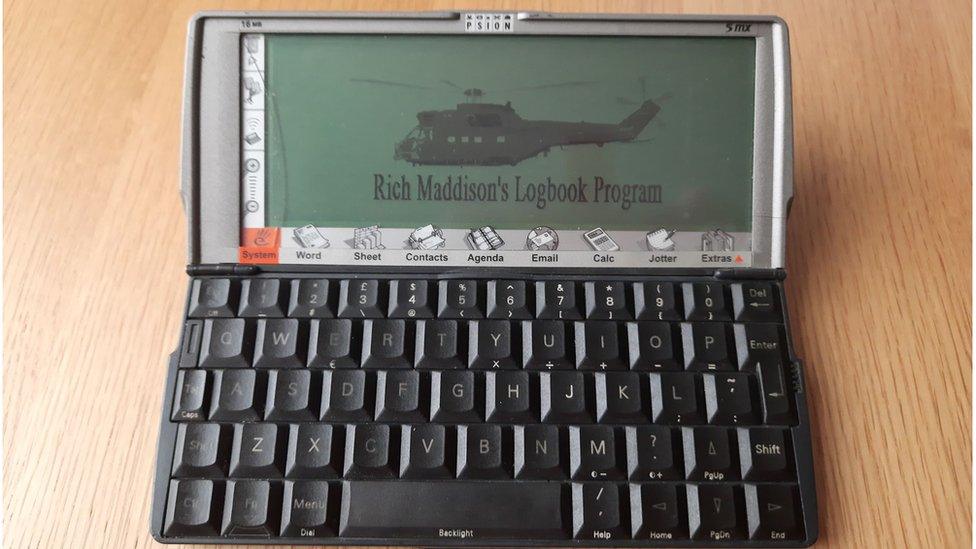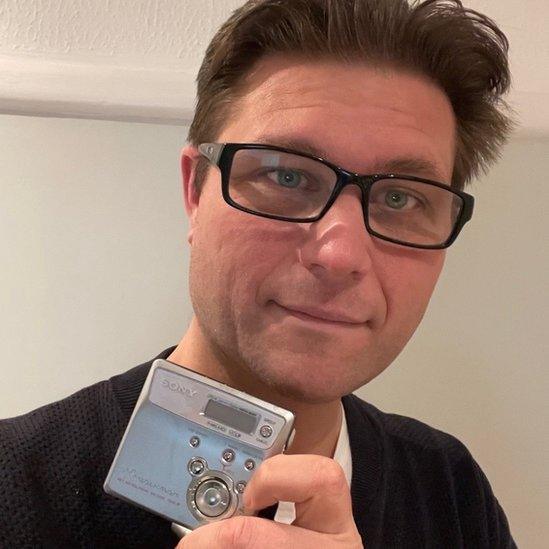Vintage technology: 'It sounds so much cleaner'
- Published

Air Vice Marshal Rich Maddison is a senior RAF officer with decades of flying experience. "As an Air Force we are as high-tech as you get, but this, this is just me."
He is referring to a miniature computer with a black and lime green screen and miniscule memory that uses AA batteries to power a 1997 design. It is a Psion 5 device and for AVM Maddison it represents his personal aviation history.
The dated device is where he keeps his own flying log. Hailing from an era when computers came with their own programming languages the Psion invited users to tinker with its limited applications. He could take fields in its address book and convert them to resemble a pilot's logbook.
Every pilot records each flight in columns listing such details as the date, aircraft type, crew names, purpose of flight, route flown etc. AVM Maddison was also issued with a physical logbook but his Psion allowed him to build an automatic monthly summary of his flying hours that could be used to tell him how many hours he'd achieved on a particular aircraft or with one of his colleagues.
Today's RAF uses its own advanced flying program to compile this data, but this lacks the personal bond AVM Maddison has with his Psion. "I'm on my third physical logbook and that's what gets signed off every year, but I get a lot more out of my Psion."

Batteries last for months on Rich Maddison's Psion 5
The AA batteries only need replacing every couple of months so he doesn't have to worry about recharging it like a contemporary device and without an internet connection it's pretty secure. It has travelled the globe with him, often when he's been in charge of a Puma helicopter, another old machine that celebrates 50 years of RAF service in 2021. "The Puma has been upgraded of course, just like my Psion!"
His logbook opens with an image of a Puma rising to fly away, a piece of graphic art he created. This very personal program has been picked up by other Nato pilots over the years.
He's happy with an iPhone and tablet and admits that the Psion "feels like a brick compared to a smartphone", but the little flash drives that feed its software are very practical. While on flying training in Norway AVM Maddison came across another pilot using an even earlier version of his logbook program. "I took out my flash drive and gave him an upgrade," he laughs.


The Psion's hard keyboard is one of the reasons this device is still doing duty after almost a quarter of a century.
Silas Brown, a supervisor in computer science at Cambridge University, still uses a Psion to collect his thoughts at events. "I am partially-sighted so I prefer typing with a real physical keyboard rather than the on-screen ones the world has switched to. Yes, there are Bluetooth keyboards, but that is an extra item to juggle. The Psion can display large print and I have written software to organise my notes in it."
He has seen his wife searching for a power point to charge her tablet computer at academic conferences while his AA battery-powered Psion ran all week.
If the thought of a computer science expert resorting to such a machine seems amusing, Dr Brown points to Cambridge's rich computer history. "When you enter the computer laboratory the first thing you see is some old valves from 1940s computers." Most of his students can't identify his Psion. "Usually they don't know what it is," he says.
Their loyal owners see a winning combination of practicality and personality in these vintage devices. And the attraction is growing. Ebay reports "a revival in retro tech" with one vintage computing item sold on its UK site every three minutes.

More than a decade old, the Zen Stone music player is still good enough for some people
Alex Warren is the author of Technoutopia, a hard look at the Silicon Valley mindset. "The book focuses on how we can limit our addiction to technology so I'm drawn to older devices that don't mean people check their screen for messages all the time," he says.
This minimalist take on tech sees Mr Warren clinging to a tiny 13-year-old device whose sole purpose is to play music. It is a Creative Zen Stone MP3 player, fed by a micro-USB cable that takes music off a PC and also charges it up.
"It can only hold 10 to 15 albums but you pick the albums you want and it plays them in full. It's a tiny, pocket-sized version of a vinyl album player. I listen to them all the way through rather than jumping around with playlists.
"[I don't want] the distractions of a screen full of stuff on Spotify or the temptation to pop over to Twitter. It's nice to be able to carry music around without being tethered to social media or a phone full of apps."
His diminutive companion is tough. Left in a pocket it survived a washing machine cycle and came out unharmed, shiny and melodious.
Durability is one reason vintage devices keep marching on. But they also allow users to shut down the mass of social media apps that sap our concentration.

Graeme Patfield says his Sony Walkman serves as a tool for mindfulness

Graeme Patfield, a communications consultant on the UK's south coast, finds mental solace in older tech. He is another advocate of musical purity via dated machines.
His Sony Walkman has been playing mini-discs copied over from a PC for nearly 20 years. "It sounds so much cleaner and sharper than anything else and it goes for ages on one AA battery," he says,
He rediscovered it during lockdown and finds its physical routine summons up pleasing memories. "It clunks. You hear it spin when it's doing something."
For Mr Patfield the mini-disc serves as a tool for mindfulness, a movement that calls for people to settle their consciousness in the moment. "You sit down and focus on the one task without anything else taking your attention away."
Clearing your mind can come at an attractive price. The average cost of vintage sound and vision items sold by eBay UK is just £37, creating what the site calls "a sustainable and retro alternative to brand new". Vintage tech is finding a future.